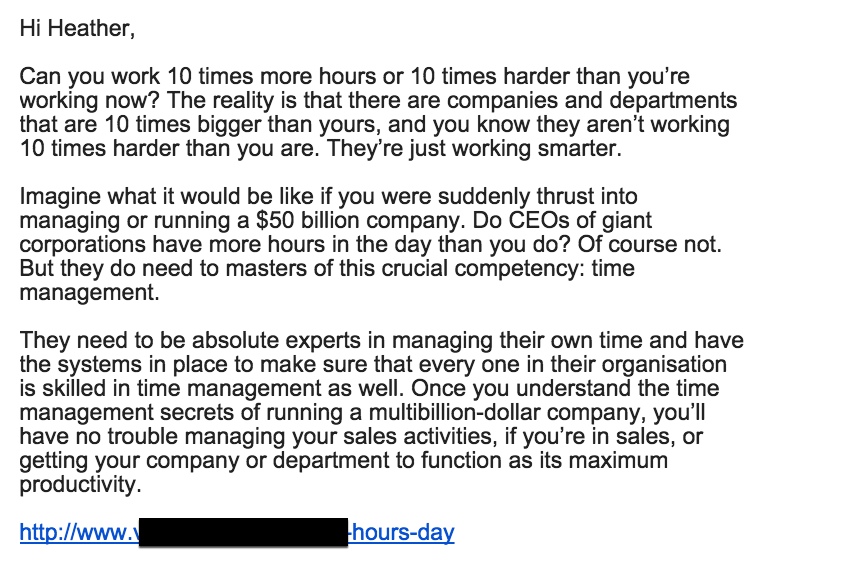How often do you actually read a cold email all the way through?
Most emails are a struggle to read all the way through, either because they’re too long, boring or fail to offer any real nuggets of valuable information. Since cold email is my business, I read through almost every cold email in my inbox, though mostly out of curiosity rather than genuine interest.
This week’s cold email critique focuses on how to write persuasive emails that grab your prospects’ attention and keep them reading until the end.
Research shows if you can get your prospect to read just 25% of your marketing copy, they’ll likely read the whole thing. Since successful cold emails should average between 2-5 sentences, you have to make every sentence count. If your opening sentence isn’t attention-grabbing, your prospects will hit delete before they ever reach your call to action.
How To Hook Your Prospects With Language That Packs A Punch
Can you work 10 times more hours or 10 times harder than you’re working now? The reality is that there are companies and departments that are 10 times bigger than yours, and you know they aren’t working 10 times harder than you are.
The opening sentence of your cold email is key because it sets the tone for the rest of your email. The goal is to draw your prospects in and entice them to keep reading.
This opening line is ineffective because it lacks a dynamic punch. It’s not engaging and it definitely doesn’t make me want to read further. Repeating the number 10 over and over isn’t clever; it’s distracting. Trying to be cute can backfire and confuse your message. So make sure that your language is clear and neat. You don’t want your prospects asking, “10 what again?”
Pro Tip #1: Cold emails should be the beginning of a conversation between you and your prospects. Start by asking a question to get your prospects thinking. While this email poses a question, it’s too long winded to provide any real impact.
Instead a better first sentence would be:
“What’s holding you back from scaling {!Company}’s sales process to the next level?”
Why Crafting Clear Emails Evokes Emotion
Imagine what it would be like if you were suddenly thrust into managing or running a $50 billion company. Do CEOs of giant corporations have more hours in the day than you do? Of course not. But they do need to masters of this crucial competency: time management.
Your cold email should always provide a clear benefit for your prospects. Being too general about your product is a great way to lose your prospects. This email is so vague I can’t even tell what the product is, or how it would benefit me. My only clue to what they do is some obscure reference to time management, which is too generic to catch my interest.
If they’re a product management tool for salespeople, they could instead say:
“By removing frictions in sales workflow, we helped [client X] save the time-cost of 1 sales rep for every 4 sales people.”
Pro Tip #2: Instead of having a long block of text, create one sentence that illustrates your product’s biggest benefit in a way that your prospects can relate to.
(Rovenko Photography)
Don’t Write Cold Emails that Leave Your Prospects Hanging In the Wind
“Once you understand the time management secrets of running a multibillion-dollar company, you’ll have no trouble managing your sales activities, if you’re in sales, or getting your company or department to function as its maximum productivity.
[link]”
One of the worst cold email mistakes is failing to include a call to action. When crafting your cold email you need to have a specific goal in mind. Just as your entire email’s copy reinforces and leads up to that, your call to action should close the loop with your goal.
What does this person want me to do? Just click a link, or do they want me to contact them? What incentive do I have to click this link? You definitely don’t want your prospects reading through your email and thinking, “now what?”
Simply including a link without explaining the benefit of it or giving a clear and persuasive call to action is a cold email fail.
Pro Tip #3: I generally dislike including links and attachments in cold emails, especially if they are the first few interactions you have with the prospect. Save your marketing materials for a drip campaign, white papers or company blog. But if you do include links, be sure to incentivize the recipient to click or open the content with a strong benefit like this:
“Watch this video to learn 3 easy tips that will help {!Company} improve its sales activities management.”




